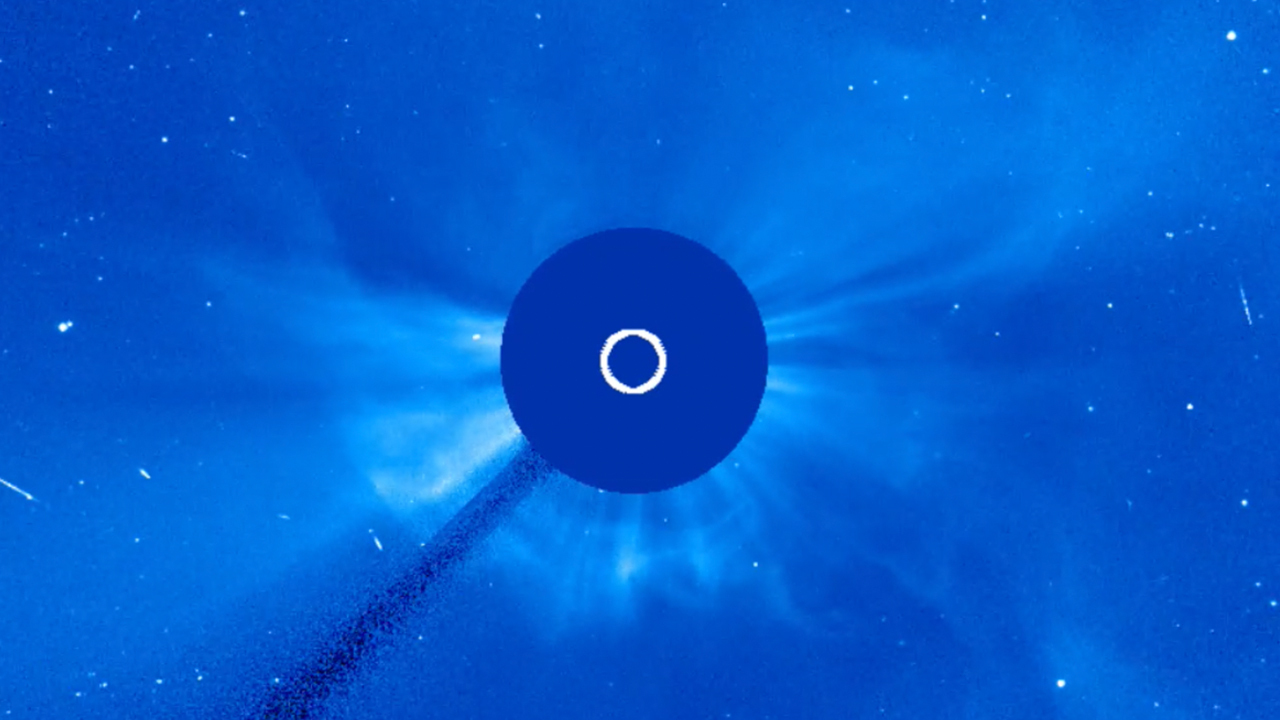Solar storm from 'cannibal' sun eruption may impact power grid and bring auroras as far south as Pennsylvania
This week's solar storm is bigger than the storm over Halloween.

The government agency tasked with monitoring space weather has warned that a powerful solar storm could interfere with power grids, satellites and radio signals — although it might also have sent the beautiful northern lights incredibly far south overnight into Thursday (Nov. 4).
The Space Weather Prediction Center (SWPC), an office within the National Oceanic and Atmospheric Administration (NOAA), has been monitoring a series of outbursts from our sun that began on Monday (Nov. 1). Since then, the sun has produced several coronal mass ejections (CMEs), which are bubbles of hot gas and magnetic field; while such activity can come from any part of the sun, the current examples have headed out into space toward Earth, making them of particular interest to humans. Some sun weather trackers dubbed one of those eruptions a "cannibal CME" after it overtook an earlier storm.
SWPC warned that as the current geomagnetic storm unfolds, the consequences may affect people's daily lives, including "voltage irregularities possible in the electric power grid, false alarms may be triggered on some protection devices" and "intermittent satellite navigation (GPS) problems," according to a NOAA statement.
Related: Sun outburst goes 'cannibal' as fast new blob overtakes a slower one
If you take a photograph of the northern lights from the solar flare, send images and comments in to spacephotos@space.com.
NOAA operates a host of satellites that can detect CMEs. The CME responsible for today's potential impacts reached the Deep Space Climate Observatory (DSCOVR) spacecraft late on Wednesday, then reached the GOES-16 satellite about 15 minutes later, according to a statement. DSCOVR is located about 1 million miles (1.5 million kilometers) away from Earth in the direction of the sun; GOES-16 is located in geostationary orbit about 22,200 miles (35,800 km) above the equator monitoring the East Coast of the U.S.
In addition to potential consequences more noticeable to everyday life, NOAA noted that spacecraft may be affected by phenomena like surface charging and orientation problems, and the storm might interfere with high frequency radio signals at high latitudes, which could affect long-distance airplane flights.
It's not all bad news, of course. The NOAA statement also notes that the geomagnetic storm may bring on particularly stunning northern lights, noting that overnight from Wednesday into Thursday the displays may have been visible from "Pennsylvania to Iowa to Oregon and points north." (Auroras also occur during the day but are much more difficult to see against a sunlit sky.)
Get the Space.com Newsletter
Breaking space news, the latest updates on rocket launches, skywatching events and more!
And the display may continue, SWPC's geomagnetic storm forecast notes, with G1 representing minor storms and G3 representing strong storms. "G1 storm levels continue to be met and solar wind conditions remain elevated and enhanced, maintaining the potential for additional periods of G2-G3 level storms," a forecast published early on Thursday reads.
In addition to the technical forecasts, SWPC also produces a visual aurora forecast for both the northern and southern hemispheres.
CMEs and other solar activity that can affect conditions across the solar system are known collectively as space weather. Space weather is generally tied to the sun's 11-year activity cycle. Currently, the sun is in the early period of what scientists have dubbed "solar cycle 25," which is forecast to peak in 2025.
Editor's note: If you hope to see the northern lights yourself, check out our guide on where and how to photograph the aurora. And if you're hoping to capture them on camera, consider our picks for the best equipment for aurora photography and how to edit aurora photos. If you need equipment, our roundups for the best cameras for astrophotography and best lenses for astrophotography can help make sure you're ready for the next aurora event.
Email Meghan Bartels at mbartels@space.com or follow her on Twitter @meghanbartels. Follow us on Twitter @Spacedotcom and on Facebook.
Join our Space Forums to keep talking space on the latest missions, night sky and more! And if you have a news tip, correction or comment, let us know at: community@space.com.

Meghan is a senior writer at Space.com and has more than five years' experience as a science journalist based in New York City. She joined Space.com in July 2018, with previous writing published in outlets including Newsweek and Audubon. Meghan earned an MA in science journalism from New York University and a BA in classics from Georgetown University, and in her free time she enjoys reading and visiting museums. Follow her on Twitter at @meghanbartels.









